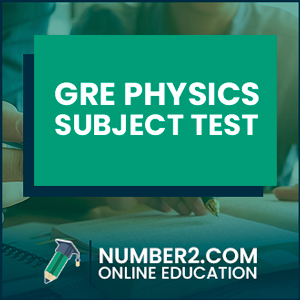 What You Should Know Before Taking the GRE Physics Section
What You Should Know Before Taking the GRE Physics Section
If you are considering a post-graduate or Ph.D. study in physics, you need to take the GRE Physics test as part of the graduate school application. It is one of the six GRE subject tests but whether you will take GRE Physics tests depend on your study area and the programs you are considering.
Most importantly, the exam revolves around material learned in the first three years of your undergraduate physics course. The essence of GRE Physics is to evaluate candidates’ physics background for those looking to continue studying physics at the master’s or Ph.D. level.
Let’s look at what’s on the GRE Physics Subject Test along with some tips on how to improve your score and ace the exam.
What is the GRE Physics Subject Test?
What is GRE Physics Used for?
The GRE physics section is a test administered by the Educational Testing Service (ETS). The purpose of the GRE Physics test is to evaluate post-graduate and Ph.D. candidates’ understanding of fundamental physics principles and how well they can use them to solve problems. Most graduate institutions require students to take the test and use the results to make admission decisions.
Because many students who expect to proceed to graduate schools apply during the first half of their fourth year, the scope of the GRE physics is basically that of the first three years of a conventional undergraduate physics course.
Thus, classical mechanics, wave phenomena and optics, electromagnetic, relativity, thermal physics, quantum mechanics, atomic and nuclear physics, mathematical methods, and laboratory techniques are among the topics covered by the 100 five-option multiple-choice questions.
What Topics and Skills are Tested on the GRE Physics Subject Test?
There are around nine topic areas that the GRE physics section covers, but from April 2021, there will only be subscores for electromagnetism, classical mechanics, and atomic physics & quantum mechanics. Each topic area accounts for a certain percentage of the test.
Classical mechanics
Classical mechanics will account for 20% of the test and will cover topics such as Newton’s laws, work and energy, kinematics, rotational motion on a fixed axis, oscillatory motion, systems of particles dynamics, 3D particle dynamics, central forces, and celestial mechanics, noninertial reference frames, Lagrangian and Hamiltonian formalism, and elementary fluid dynamics.
Electromagnetism
Electromagnetism covers 18% of the test from topics including free space magnetic fields, electrostatics, DC circuits, Lorentz force, AC Circuits, Maxwell’s equations, induction, electromagnetic waves, electric and magnetic fields ion matter.
Thermodynamics and statistical mechanics
Thermodynamics and statistical mechanics will account for 10% of the exam testing on equations of state, thermodynamic processes, kinetic theory, law of thermodynamics, equations of state, statistical concepts and thermodynamics quantities calculations, heat transfer, and thermal expansion, ideal gases, and ensembles.
Quantum mechanics
Quantum mechanics will cover 12% of the paper with questions on fundamental concepts, Schrodinger equation solutions, angular momentum, spin, elementary perturbation theory, wave function symmetry, and harmonic oscillators.
Optics and Wave Phenomena
Optics and Wave Phenomena covers interference, superposition, diffraction, wave properties, geometric optics, Doppler effect, and polarization and only accounts for 9% of the test.
Atomic physics
Atomic physics, which accounts for 10% of the test, covers the Bohr model, properties of electrons, atomics structure energy quantization, selection rules, x-rays, black-body radiation, and atoms in magnetic fields.
Special Relativity
Special Relativity cover 6% of the test on topics that include time dilation, simultaneity, velocity addition, Lorentz transformation and four vectors, length contraction, and energy & momentum.
Laboratory Methods
Laboratory Methods covers electronics, instrumentation, error analysis, radiation detection, counting statistics, laser and optical interferometers, charged [article interaction with mater, dimension analysis, statistics, and fundamental probability analysis.
GRE Physics Structure, Format, & Time length
The GRE Physics exam comprises 100 questions that the student has to answer within 2 hours and 50 minutes (170 minutes), implying that you will have to attempt each question in less than two minutes.
Content tested in this section entails material learned in the first three years of your undergraduate physics program. All questions are multiple-choice questions with five answer choices provided.
The test is cleverly constituted, and most questions will require more than recalling the applicable equations and diving into figures, but more physical intuition is necessary.
How is the GRE Physics Section Graded?
Are all questions graded?
All GRE Physics section questions contribute to your final score. The number of correctly answered questions will count to the total correct score, which is then converted into a reported scaled score. The scaling ensures uniformity in the grading of the test irrespective of the edition the candidate took.
Physics section total scores are scaled between 200 and 990. Scores are looked at in terms of percentiles, and a good score will vary depending on graduate school.
What is a Good Physics GRE Score?
A good physics GRE score is above 750 putting your score in the 90th percentile. Anything between 700-750 may not be good enough to get you into the college of your choice.
Most students score around the 50th percentile, which is a score of approximately 600. Any GRE Physics score below 600-650 is not high enough to be seriously considered for top tier university programs.
When can You Take the Physics GRE Test?
When is the GRE Physics Test Dates Offered?
The GRE Physics test can be done three times a year in April, November, and December by students looking to join the graduate school and are in the final year of the undergraduate program. Since the scores are processed within a month, and most graduate schools are due in January and December, November is the last chance for a student to join graduate school the following year to take the GRE test.
However, of the December date classes with the date of taking final undergraduate exams in most cases, it is ideal for taking the test in April. That way, you will not have to be thinking of GRE as you complete your graduate application.
The advantage of the April date is that you can “fall back” in November if you don’t get a good score on the April test.
What can You Bring to the GRE Physics Test?
Snacks and drinks are not allowed in the exam, and you are not allowed any breaks during the last half hour of the exam. You should bring your ID, confirmation voucher/email, pencil, and eraser.
You are not allowed to bring a calculator to the GRE Physics test. Watches, accessories, or a calculator are not allowed.
How Much Does the Physics GRE Cost?
The GRE Physics test costs $130 to take, and you are allowed to lost four schools/scholarships where you will want ETS to send your scores for free.
It is important to keep track of the schools you have sent the score to because additional reports will cost you $15 per score report and an extra phone service charge of $6.

